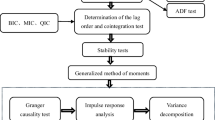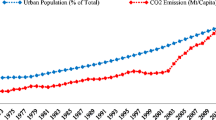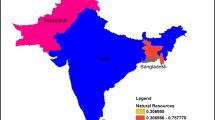Abstract
The main aim of this article is to examine empirically the impact of urbanization on carbon dioxide emissions in Singapore from 1970 to 2015. The autoregressive distributed lags (ARDL) approach is applied within the analysis. The main finding reveals a negative and significant impact of urbanization on carbon emissions in Singapore, which means that urban development in Singapore is not a barrier to the improvement of environmental quality. Thus, urbanization enhances environmental quality by reducing carbon emissions in the sample country. The result also highlighted that economic growth has a positive and significant impact on carbon emissions, which suggests that economic growth reduces environmental quality through its direct effect of increasing carbon emissions in the country. Despite the high level of urbanization in Singapore, which shows that 100 % of the populace is living in the urban center, it does not lead to more environmental degradation. Hence, urbanization will not be considered an obstacle when initiating policies that will be used to reduce environmental degradation in the country. Policy makers should consider the country’s level of economic growth instead of urbanization when formulating policies to reduce environmental degradation, due to its direct impact on increasing carbon dioxide emissions.


Similar content being viewed by others
References
Akpan GE, Akpan UF (2012) Electricity consumption, carbon emissions and economic growth in Nigeria. Int J Energy Econ Policy 2(4):292–306
Ali HS, Law SH, Zannah TI (2016) Dynamic impact of urbanization, economic growth, energy consumption, and trade openness on CO2 emissions in Nigeria. Environ Sci Pollut Res:12435–12443
Al-Mulali U, Ozturk I, Lean HH (2015) The influence of economic growth, urbanization, trade openness, financial development, and renewable energy on pollution in Europe. Nat Hazards 79(1):621–644
Bloom DE, Canning D, Fink G (2008) Urbanization and the wealth of nations. Science 319(5864):772–775
Cole MA, Neumayer E (2004) Examining the impact of demographic factors on air pollution. Popul Dev Rev 2(1):5–21
Dietz T, Rosa EA (1994) Rethinking the environmental impact of population, affluence and technology. Human Ecology Review 1:277–300
Dietz T, Rosa EA (1997) Effects of population and affluence on CO2 emissions. Proceedings of the National Academy of Sciences USA 94(1):175–179
Dogan E, Turkekul B (2016) CO2 emissions, real output, energy consumption, trade, urbanization and financial development: testing the EKC hypothesis for the USA. Environ Sci Pollut Res 23(2):1203–1213
Engle RF, Granger CWJ (1987) Cointegration and error correction: representation, estimation and testing. Econometrica 55:251–276
Farhani S, Ozturk I (2015) Causal relationship between CO2 emissions, real GDP, energy consumption, financial development, trade openness, and urbanization in Tunisia. Environ Sci Pollut Res 1–14
Farhani S, Shahbaz M, Arouri M, (2013) Panel analysis of CO2 emissions, GDP, energy consumption, trade openness and urbanization for MENA countries. MPRA Paper No. 4925
Glaeser E (2011) Cities, productivity, and quality of life. Science 333:592–594
Hossain S (2012) An econometric analysis for CO2 emissions, energy consumption, economic growth, foreign trade and urbanization of Japan. Low Carbon Econ 2012(3):92–105
Johansen S (1988) Statistical analysis of cointegrating vectors. J Econ Dyn Control 12:231–254
Johansen S, Juselius K (1990) Maximumli kelihood estimation and inference on cointegration–with applications to the demand for money. Oxf Bull Econ Stat 52:169–210
Liu Y (2009) Exploring the relationship between urbanization and energy consumption in China using ARDL (autoregressive distributed lag) and FDM (factor decomposition model). Energy 34(11):1846–1854
Martinez-Zarzoso I, Maruotti A (2011) The impact of urbanization on CO2 emissions: evidence from developing countries. Ecol Econ 70:1344–1353
Narayan PK (2005) The saving and investment nexus for China: evidence from cointegration tests. Appl Econ 37:1979–1990
Ozturk I, Acaravci A (2010) CO 2 emissions, energy consumption and economic growth in Turkey. Renew Sust Energ Rev 14(9):3220–3225
Ozturk I, Acaravci A (2013) The long-run and causal analysis of energy, growth, openness and financial development on carbon emissions in Turkey. Energy Econ 36:262–267
Percentage of global urban population is found CIA fact book through the link: https://www.cia.gov/library/publications/the-world-factbook/fields/2212.html accessed on 5th August, 2016.
Pesaran MH, Pesaran B (1997) Working with Microfit 4.0: interactive econometric analysis;[Windows version]. Oxford University Press, Oxford
Pesaran MH, Shin Y, Smith RP (1999) Pooled mean group estimation of dynamic heterogeneous panels. J Am Stat Assoc 94(446):621–634
Pesaran MH, Shin Y, Smith RJ (2001) Bounds testing approaches to the analysis of level relationships. J Appl Econ 16:289–326
Ponce de Leon, Barido D, Marshall JD (2014) Relationship between urbanization and CO2 emissions depends on income level and policy. Environmental science & technology 48:3632–3639
Poumanyvong P, Kaneko S (2010) Does urbanization lead to less energy use and lower CO2 emissions? A cross-country analysis. Ecol Econ 70(2):434–444
Poumanyvong, P., Kaneko, S., & Dhakal, S (2012) Impacts of urbanization on national residential energy use and CO2 emissions: evidence from low-, middle-and high-income countries (No. 2-5). Hiroshima University, Graduate School for International Development and Cooperation (IDEC)
Saidi K, Mbarek MB (2016) The impact of income, trade, urbanization, and financial development on CO2 emissions in 19 emerging economies. Environmental Science and Pollution Research: 1–10
Shahbaz M, Sbia R, Hamdi H, Ozturk I (2014) Economic growth, electricity consumption, urbanization and environmental degradation relationship in United Arab Emirates. Ecol Indic 45:622–631
Sharma SS (2011) Determinants of carbon dioxide emissions: empirical evidence from 69 countries. Appl Energy 88(1):376–382
Singapore statutes online (2016) Accessed on 5th October, 2016 through the link http://statutes.agc.gov.sg/aol/search/display/view.w3p;page=0;query=DocId%3A%227cc1971c-6237-4f5a-a75c-dd378fc80179%22%20Status%3Ainforce%20Depth%3A0;rec=0
Stewart Jr, CT, & Lee, JH (1986) Urban concentration and sectoral income distribution. The Journal of Developing Areas, 3:357–368.
United Nations (2014): http://www.un.org/en/development/desa/news/population/world-urbanization-prospects-2014.html
York R, Rosa EA, Dietz T (2003) STIRPAT, IPAT and IMPACT: analytic tools for unpacking the driving forces of environmental impacts. Ecol Econ 46(3):351–365
Zhang C, Lin Y (2012) Panel estimation for urbanization, energy consumption and CO 2 emissions: a regional analysis in China. Energy Policy 49:488–498
Author information
Authors and Affiliations
Corresponding author
Additional information
Responsible editor: Marcus Schulz.
Electronic supplementary material
ESM 1
(XLSX 10 kb)
Rights and permissions
About this article
Cite this article
Ali, H.S., Abdul-Rahim, A. & Ribadu, M.B. Urbanization and carbon dioxide emissions in Singapore: evidence from the ARDL approach. Environ Sci Pollut Res 24, 1967–1974 (2017). https://doi.org/10.1007/s11356-016-7935-z
Received:
Accepted:
Published:
Issue Date:
DOI: https://doi.org/10.1007/s11356-016-7935-z




